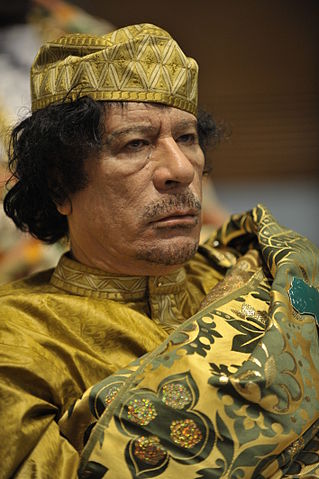Desert in Bloom: Media, Symbolism, and the Death of Dictators
 The morning I awoke to the news that deposed and now-deceased Colonel Muammar Qaddafi of Libya was dead, I felt a lingering sense of unreality. Photos and videos snapped from mobile phones trickled in, portraying the seconds after his dissolution and the last moments of his life. Slowly, a picture emerged of the humiliating capture and ignominious death of one of the most feared and hated men in the world. What is most striking about this unprecedented depiction of the end of a ruler is its utter incongruence with the representation we see so often of men who occupy offices of glory or power. This indicates a radical shift in how people have begun to view their leaders and proves the power and importance of the diffusion of information and access to media; on a deeper level, however, it points to the importance of symbolism (in many forms) in bestowing and removing power.
The morning I awoke to the news that deposed and now-deceased Colonel Muammar Qaddafi of Libya was dead, I felt a lingering sense of unreality. Photos and videos snapped from mobile phones trickled in, portraying the seconds after his dissolution and the last moments of his life. Slowly, a picture emerged of the humiliating capture and ignominious death of one of the most feared and hated men in the world. What is most striking about this unprecedented depiction of the end of a ruler is its utter incongruence with the representation we see so often of men who occupy offices of glory or power. This indicates a radical shift in how people have begun to view their leaders and proves the power and importance of the diffusion of information and access to media; on a deeper level, however, it points to the importance of symbolism (in many forms) in bestowing and removing power.
Symbolism’s power is most visible in the auras of invincibility, heroism, or infamy, previously imbued to leaders by the institutions of power and the strength of military force, which often allowed unchallenged control of nations. Yet with the revelatory power and inexorable expansion of this new media, these auras have been slain, or at least irrecoverably blemished, as surely as Qaddafi lay dying on the ground. The recorded evidence of summary execution proves the mortality of the once-immortal figure and negates the necessity of judicial battle even as it stains the justice of his death.
But even this empowering narrative traverses a dangerous edge. The farce and tragedy of the scene nearly fell prey to the image of the destruction of a nation, the gash on Qaddafi'shead mirroring the psychic wound of another once-great Arab sovereign state reduced to its knees at the hands of Western imperialism. Such an interpretation is powerful – and would be almost natural to make – were it not for the fact that the conquerors are not foreign occupiers, but oppressed citizens finally taking power back into their own hands.
This tension between dual, opposite connotations of people-power and occupation stems from at least a half-century of political philosophy that emerged from Nasserism and the Arab nationalism of the 1950s. The idea of the leader as the head and the savior of the nation, deserving of loyalty, sacrifice, and unquestioned gratitude, grew out of the perpetual warfare and stagnation since the beginning of the Israeli conflict; the reality of a brutal dictator clashes with the ideal of the guiding leader, and it is this that allows for a dual interpretation of the death of a dictator. This is why Saddam Hussein, gaunt and bearded and undignified, captured by a U.S. soldier and tried and executed by the U.S.-allied regime, could become a symbol of yet another great defeat of an Arab nation even as he was almost universally reviled, while Qaddafi's capture and death become a symbolic victory for the larger “Arab nation” in the popular sense.
This is not to say that the danger and power of symbolism here is completely dead. There may be followers of Qaddafi that indeed see the stumbling old man, almost certainly executed in understandably cold blood, as a heroic martyr. It is to avoid the establishment of a shrine that the government has kept his burial ground a secret. On the other hand, his rotting corpse was kept open and available for public viewing for several days for the sake of convincing the public that indeed, the madman is dead. It is hoped that this will help avoid the conspiracy theories that float around many dead public figures.
Regardless, both the positive and negative perspectives necessarily acknowledge the power that such a view contains; for the first time, this actionable knowledge is available to billions of citizens. New media that allows for unfettered access to current events also shackles us to the lens that captures it and the lens that transmits it. History becomes like literature, ripe with meaning, interpretation, and moral framing. News becomes more than just the reiteration of facts and occurrences, evolving into the stage on which the viewer is handed a worldview. The video of Saddam Hussein becomes triumph for Americans and defeat for Arab nationalists; the video of Qaddafi becomes the civilian’s triumph for the democrats and the victory of chaos over stable, if brutal, order for the regressives. The difference is of course, the context of the speaker. Al Jazeera and Al-Qaeda, the United States, and the United States of Africa (Qaddafi's favorite project), have very different viewpoints and thus very different symbolic interpretations of the same events. The future of media is a mixed and contradictory blessing. We are ever more free to learn and to assert our power, and yet we become all the weaker and more susceptible to manipulation.
Qaddafi is dead; this is indeed the end of an era for Libya. But more importantly, it may very well mark the end of an era for the world as a whole.
